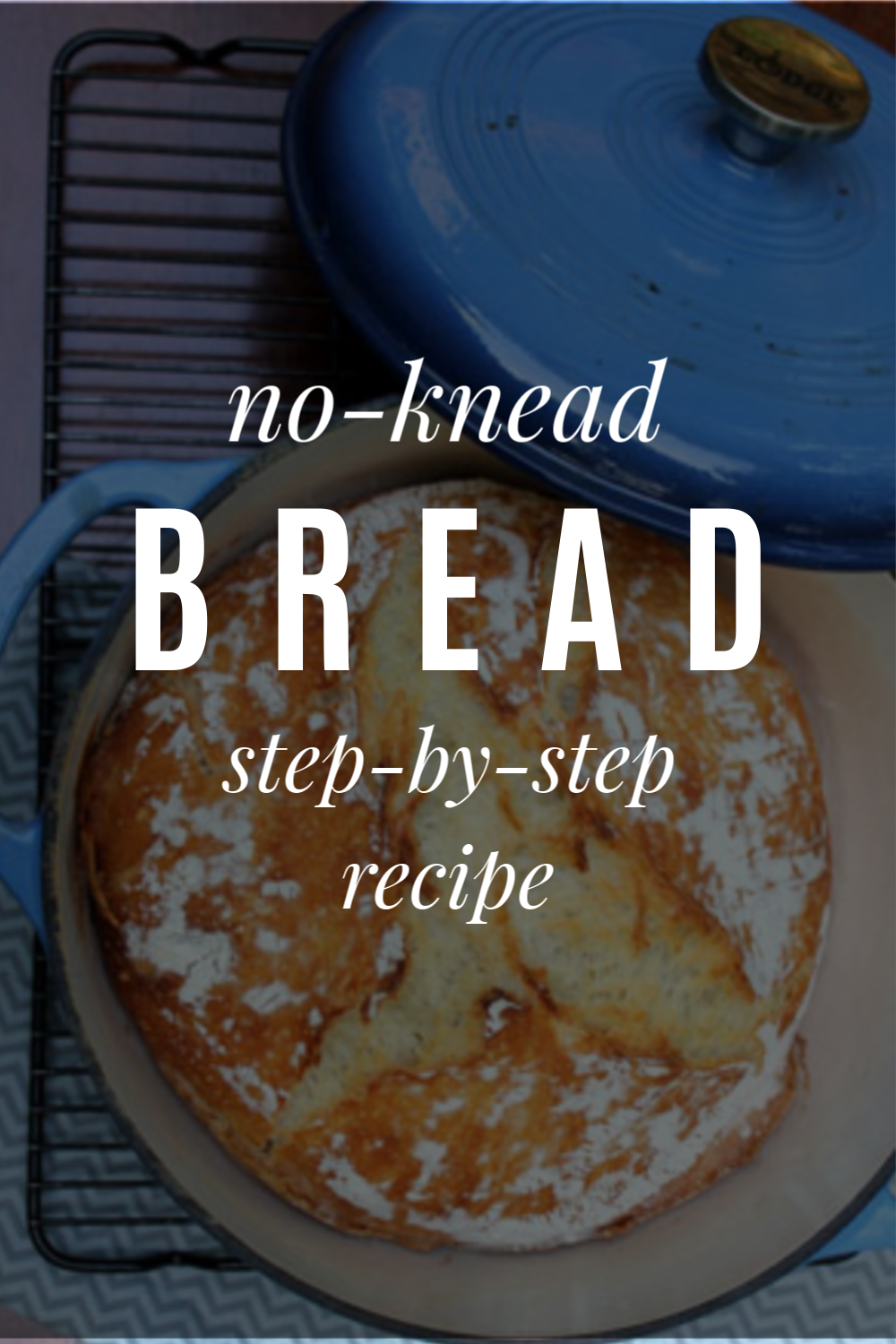
No-Knead Bread Recipe
If you have been hanging out around Frugal Living NW for awhile, you know that I am a big believer in making food from scratch at home. With a few exceptions, I prefer creating something in my own kitchen to buying it in the grocery store.
Bread can be tricky, though. There is some stiff competition out there, and it is tough to replicate a commercial oven’s heat and steam in a normal home kitchen.
For the last several years, I thought that Artisan Bread in 5 Minutes was the best thing since, well, sliced bread. It was simple, and we were content with the results. That is, until last summer when our neighbor brought over a beautiful, delicious loaf of home-baked bread. We had to know her secret. One phone call, and she came back with the book, My Bread by Jim Lahey (Amazon).
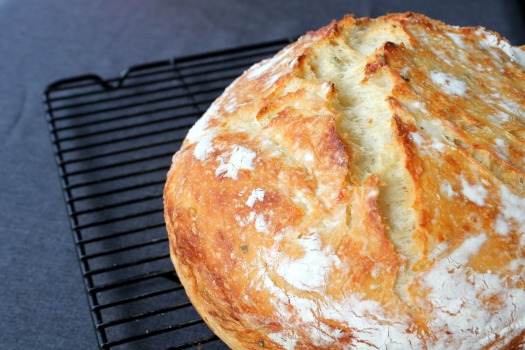
We have been baking bread using this method ever since. I can count on one hand the number of times I have bought bread in the store since then, because I can now make an artisan-quality loaf at home for a fraction of the cost.
I am telling you, this is consistently the best bread I have ever made in my kitchen. Okay, enough gushing. Let’s make some bread.
The only changes I have made to Lahey’s method is to double the amounts and adjust the baking time and temperature to achieve a bigger loaf with a thinner crust.
Oh, and don’t be put off by all these steps. This is totally possible for home bakers at any skill level. I wanted to give you the confidence to do this on your own. A concise recipe can be found at the bottom of this post.
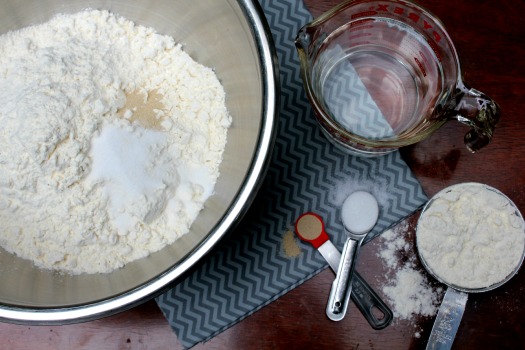
The ingredients are simple: flour, water, salt, and yeast. My husband calculated this bread costs 74¢ per loaf (using Bob’s Red Mill flour & Costco yeast).
Oh, wait! Don’t forget to factor in the roughly 8 cents of energy used to bake it for an hour. No, I’m serious. My husband really does think about this stuff! He’s funny.
So, there you go. A whopping 81¢ for a substantial 2.5 pound loaf of bread. That is crazy cheap.
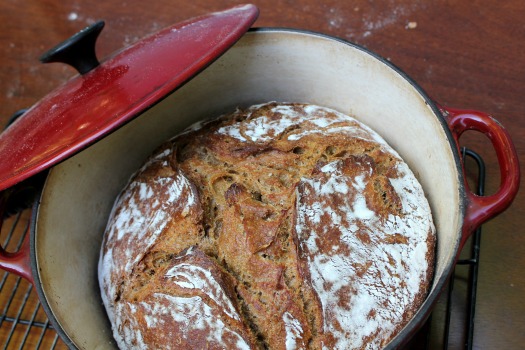
If you want to use some whole wheat flour, substitute 3 cups of whole wheat for 3 cups of the all-purpose flour (3 cups whole wheat and 3 cups of unbleached flour for a total of 6 cups) and add 3 Tablespoons of molasses (optional). This will produce a slightly sweeter, denser loaf of bread. Delicious.
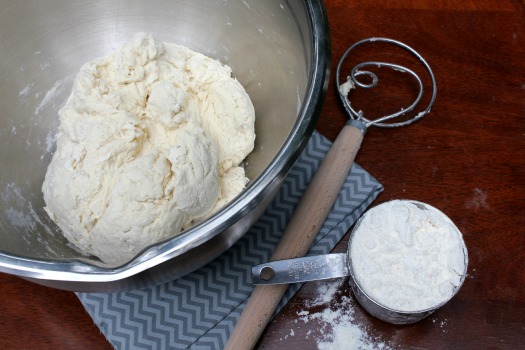
Combine the dry ingredients, add the water, and stir to combine (the funky looking wood-handled item is the amazing Danish Dough Wisk — makes stirring stiff dough a snap). The dough should be wet and sticky. Depending on the temperature and humidity in your home, you may need to add a little more flour or water, 1 Tablespoon at a time. So far, these steps are exactly the same as the 5 Minute method.
The main differences are that you use significantly less yeast (1/2 teaspoon vs. 1 1/2 Tablespoons) and significantly more initial rise time (12-18 hours vs. 2 hours).
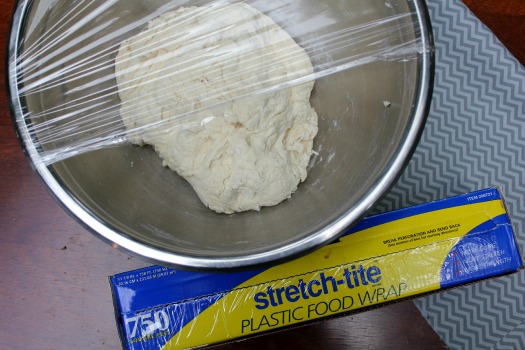
Once the ingredients are completely combined, cover the bowl with plastic wrap and leave it on the counter to rise for 12-18 hours. This slow rise aids in the fermentation of the yeast, giving the bread a better flavor.
Okay, I know what some of you are thinking: 12-18 hours! That’s ridiculous! Who has that kind of time?! I get it.
However, here are two things to consider:
- Once you get into a rhythm of baking your own bread, it’s not a big deal. I start mine in the afternoon or evening and bake it the next morning or afternoon. This would also be an easy weekend routine.
- Just like the title claims, this bread requires no kneading. It is not fussy, temperamental dough. You can produce a delicious loaf of bread with very little hands-on effort & experience.
You’ll know your dough is ready when it has risen in the bowl, smells yeasty, darkened slightly, and is covered with small bubbles.
Using well floured hands, shape and tuck the sticky dough into a rough ball. You can also fold it over a couple times on a well-floured surface. It doesn’t have to be perfect; just keep quickly tucking the dough underneath with your fingertips until you have a semi-smooth dough ball. The dough should be wet but manageable; you don’t want a wet blob so sticky that you can’t shape it into a ball.
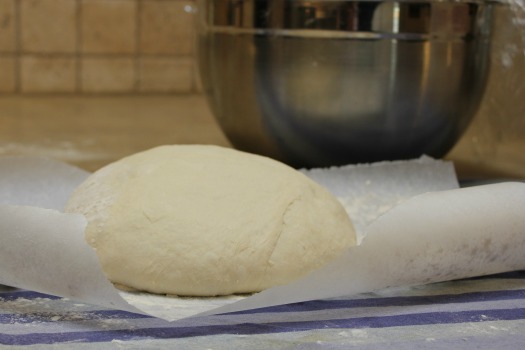
Take a clean linen or cotton tea towel (not terry cloth) and dust it with flour, cornmeal, or wheat germ to prevent the dough from sticking to the towel as it rises. You can also use a floured square of parchment paper on the towel to make the dough ball easier to handle. Place the dough ball, seam side down, in the middle and dust with more flour.
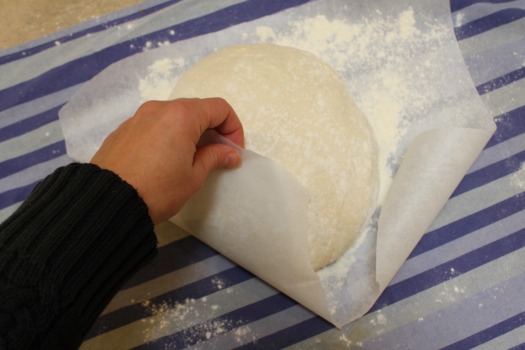
Cover the dough with the (parchment paper and) towel and let it rise for 1-2 hours at room temperature, until doubled in size. During the last 30 minutes of rise time, place a heavy lidded 6-8 quart pot, like a Dutch oven, in a cold oven and preheat it to 425 degrees.
Confession: I own three Dutch Ovens. I use them all the time. They are incredibly versatile and worth the investment. If you don’t own one, you could also make this in any lidded pot, provided it is oven-safe at such high temperatures. Also, check the knob on your pot. If it isn’t rated for such high heat, you’ll want to remove it or cover it with foil. You can also buy an inexpensive replacement knob that is rated for higher temps!
Okay, this is the trickiest part of the entire operation. Remove the lid from the piping hot Dutch Oven, slide your hand underneath the towel or parchment paper, and flip the risen dough (seam side up now) into the pot. Try to flip close to the pot or the flour will fly everywhere. Remove the towel or paper and set aside.
This might take a bit of practice, but again it doesn’t have to be perfect. Some of my worst flips have produced my most beautiful loaves. I love what Lahey writes, “…even the loaves that aren’t what you’d regard as perfect are way better than fine.”
Place the lid back on top and slide the pot back into the hot oven.
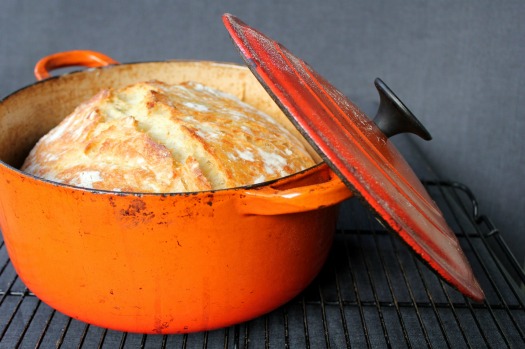
Bake it for 40-50 minutes. Remove the lid. Bake for another 5-10 minutes, until golden chestnut brown. The internal temperature should be around 200 degrees. You can check this with a meat thermometer if you’re nervous about knowing when your loaf is done.
Oh man, your house will smell so good about right now.
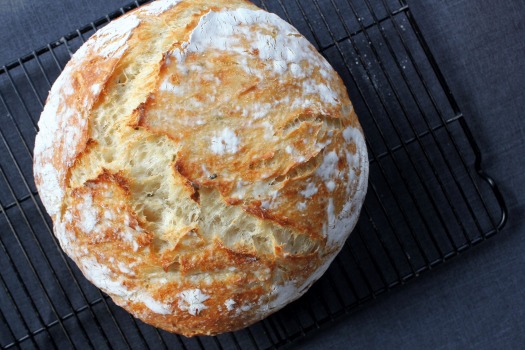
Place the loaf on a cooling rack. You will hear it crackling as it cools. Use every ounce of self-control to resist cutting into it until it is “quiet”; cutting it too soon will make the bread dense and gummy.
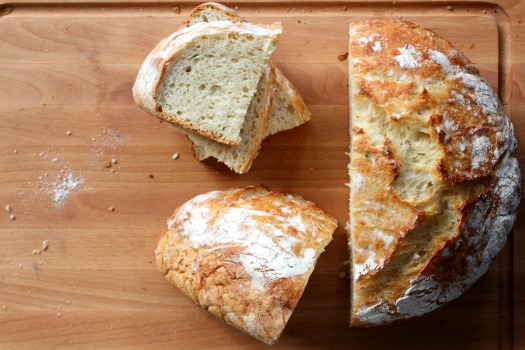
This bread is best the first 2-3 days. I just store my leftover loaf inside the Dutch oven on the countertop. Using plastic wrap will soften the crust. Dry, leftover bread makes great bread crumbs, toast, French toast, or croutons!
Enjoy. And pat yourself on the back. You just baked an amazing loaf of bread!
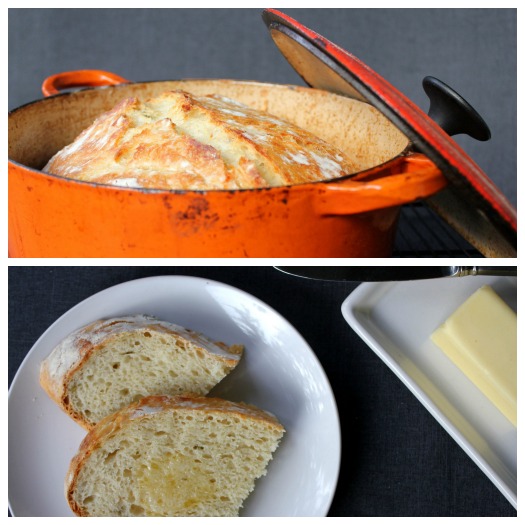
Basic No-Knead Bread
Slightly adapted from Jim Lahey’s My Bread
Ingredients
6 cups bread flour (recommended) or all-purpose flour, plus more for work surface
1/2 t. instant or active-dry yeast
2 1/2 t. salt
2 2/3 c. cool water
- In a large bowl, combine the flour, yeast, and salt. Add the water and stir until all the ingredients are well incorporated; the dough should be wet and sticky. Cover the bowl with plastic wrap. Let the dough rest 12-18 hours on the counter at room temperature. When surface of the risen dough has darkened slightly, smells yeasty, and is dotted with bubbles, it is ready.
- Lightly flour your hands and a work surface. Place dough on work surface and sprinkle with more flour. Fold the dough over on itself once or twice and, using floured fingers, tuck the dough underneath to form a rough ball.
- Place a full sheet/large rectangle of parchment paper on a cotton towel and dust it with enough flour, cornmeal, or wheat bran to prevent the dough from sticking to the parchment paper as it rises; place dough seam side down on the parchment paper and dust with more flour, cornmeal, or wheat bran. Pull the corners of parchment paper around the loaf, wrapping it completely. Do the same with the towel. Let rise for about 2 hours, until it has doubled in size.
- After about 1 1/2 hours, preheat oven to 425 degrees. Place a 6-8 quart heavy covered pot, such as a cast-iron Dutch oven, in the oven as it heats. When the dough has fully risen, carefully remove pot from oven. Unwrap the towel and parchment paper from around the dough and slide your hand under the bottom of the dough ball; flip the dough over into pot, seam side up. Pull the parchment paper off, scraping any stuck dough into the pan. Shake pan once or twice if dough looks unevenly distributed; it will straighten out as it bakes.
- Cover and bake for 40 minutes. Uncover and continue baking for 10-15 more minutes, until the crust is a deep chestnut brown. The internal temperature of the bread should be around 200 degrees. You can check this with a meat thermometer, if desired.
- Remove the bread from the pot and let it cool completely on a wire rack before slicing.
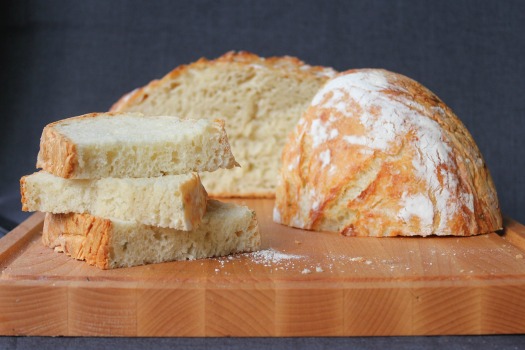
Here are a couple options for Dutch Ovens. Any heavy, lidded 5-8 quart pot (seasoned cast iron or enamel coated) would work with this recipe. Lodge has the best prices/options for dutch ovens on Amazon.
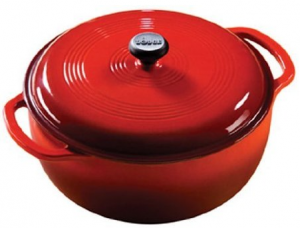
Lodge Logic Dutch Oven in Island Spice Red (6 Quart)
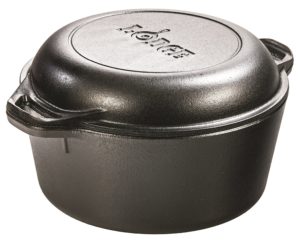
Lodge Cast Iron Double Dutch Oven (5 Quart)
If you already have a dutch oven (or find a deal on a lesser-known brand) that doesn’t have a knob rated for high temps, replace it! There are some really affordable options.
Got questions? You are in good company. Go here for the complete FAQ list.
Looking for more variations to the no-knead bread recipe? We’ve created a list with sweet and savory varieties, including the following:
- Cranberry Orange
- Four Cheese
- Sandwich Bread
- Dark Chocolate Coconut
- Tomato Basil Cheese
- Whole Wheat
Looking for more delicious bread recipes?
Find more delicious recipes on our Recipe Page!
Follow Frugal Living NW on Pinterest!
Fantastic range of boards from best recipes and tips for frugal living to gardening and budgeting help.
This post may contain affiliate links. See the disclosure policy for more information.
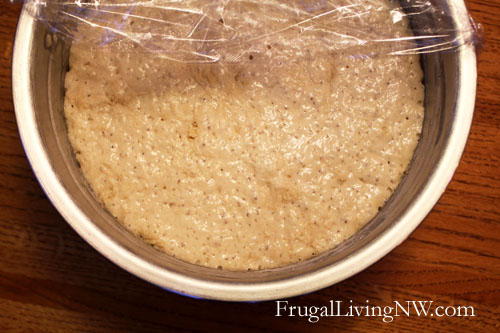
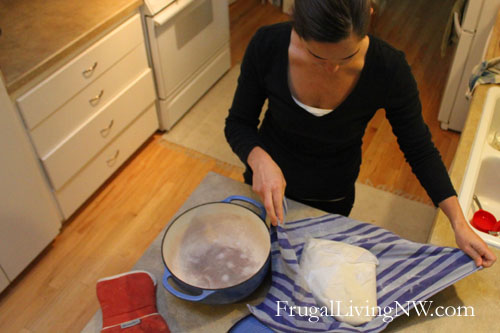
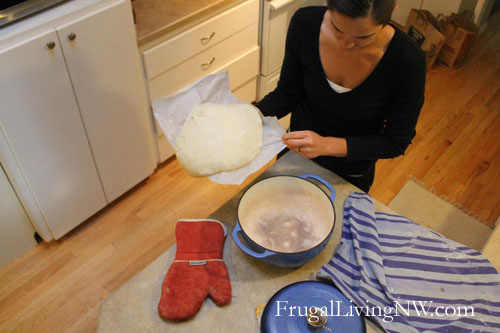

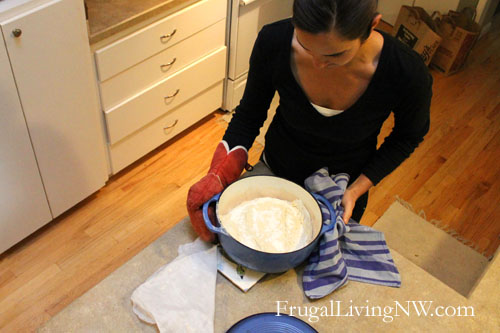
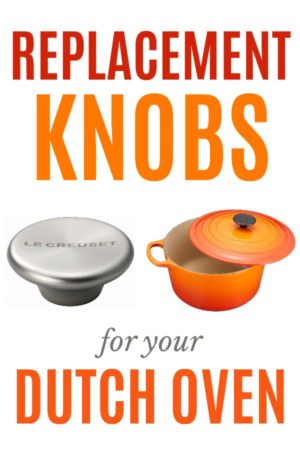

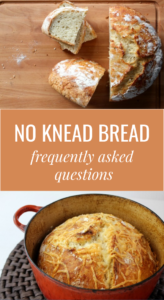
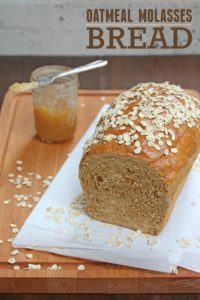
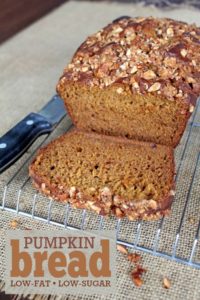
Thanks a lot for your reply, Emily. I live in France so I’ll try to find the equivalent to your yeast. I can’t wait to try it out!
Emily, this bread is fabulous! There is something inherently wrong with the bread here and we have not had sandwiches since 1996, and I am not kidding you. It is either squishy wet or all dried out and hard. It also seems to have no salt. (Salt police, it’s too late for us, we’re fine, thank you very much). I have had grilled cheese and DH has had hot turkey sandwiches each day since I made this on Monday. See my comment to Zahra above. Also, I wiped my Dutch oven out with olive oil and it imparted a wonderful, subtle flavor. I will be making a half recipe twice a week and trying lots of combinations. Thank you, thank you, thank you!
I made this about a month ago and couldn’t believe the big beautiful delicious loaf it made with really no work! I’ve been making bread from scratch for 35 years and it involves much work- needing, making sure the temp is just right so you don’t kill the yeast etc. This bread reminds me of the bread we had in France-yummy! Thanks so much for sharing your recipe. I have another batch stirred up to bring to my sister’s cousin reunion tomorrow and am excited to have them taste it with her soup. 🙂
Thanks for sharing this recipe, I’m definately going to try this!
I was just wondering; are the degrees in this recipe fahrenheit or celcius? My oven (I live in the Netherlands) displays the temperatures in celcius, but I have no idea if it’s the same for US ovens, and I don’t want to end up with a blackened or underdone loaf :p
U.S. uses Farenheit as heat measurement…. try googling (or bing’ing) it (ie. farenheit conversion to celcius) to get your info.
Does anyone have experience making small “boules” out of this recipe/method? I’m wanting some to hollow out and serve clam chowder in. Would I just cut the sticky dough into pieces, roll them in flour, then let raise as usual, and space a bit apart in parchment-lined dutch oven ? I’m thinking a ½ recipe should be perfect amount to make 4 boules. Hopefull they wouldn’t end up attached to each other, like sweet yeast rolls & need to tear apart….
This recipe makes wonderful boules! I bake them separately in small 1 quart lidded pots. The small pot gives them the right size for to serve soup in them.
I have a 5 quart one but it’s not cast iron.
can I cut this recipe in half? My dutch oven is only 3
1/2 quarts.
Yes, ½ recipe works just fine. I only do ½ on purpose, as there’s only 2 of us to eat the bread & don’t want it to spoil – we usually eat up the smaller loaf in 4 days. If not, I put in ziploc in fridge. By the way, I use my 6 qt. dutch oven for the ½ recipe – doesn’t affect the outcome at all 🙂 Also, makes sense to do just ½ recipe when I’m experimenting w/ addition of “extra” (herbs, cheese, nuts, different flour, etc.) Have fun & enjoy!
can’t wait to try this!
Do I need to spray the dutch oven with pam to prevent the bread from sticking?
I just keep the same piece of parchment paper under it that dough rises on for those last 2 hrs. This also makes it so easy to pull the loaf out of pot after baking – just hold onto the corners & pull out of blasting hot pot!
Mandy, I didn’t use parchment paper, but I wiped the Dutch oven out really well with olive oil and the bread came out great. The oven temp is high enough so that the loaf just popped right out. Good Luck, This is really easy once you get going!
I have my first batch of no-knead bread rising on the counter. When I heard about this I found this website, the original Mark Bittman article and follow up and the Rose Berenbaum website where it was discussed. Mark Bittman said to use 430 grams of flour and Rose Berenbaum said to use 468 grams of flour so I got out my kitchen scale. To my surprise, my 3 cups of flour weighed about 360 grams! So I might not be measuring it the same way they do. If your dough is really wet you might try weighing your flour to see if it is about what Mark Bittman recommends.
Hi!
I in high school (but an experienced baker- I plan to open my own someday) and made this for a school project. It was so easy I actually thought I was doing something wrong as I have never made yeast bread before, but it seems this bread is pretty foolproof. It turned out great despite the longer rise time it had while I was at school/ afternoon activities and I am waiting for it to cool so I can try it! It smells delicious!!! I was wondering if you think it would work to bake in muffin tins as dinner rolls? I know it would eliminate the lid option so maybe make it softer? Just wondering what you thought! thanks for the great recipe!
This deserves a reply IMO
Emily might have just missed it. There are over 600 comments on this post. I’m sure she’ll reply when she gets the chance.
hey when you say subsitute wheat flour for 3 cups of the other do you mean in place of. Like 3 wheat and 3 white or just 3 whole wheat for the entire loaf. Cuz everytime I use whole wheat flour in a white recipe it is way off.
Hi, Crystal! You would substitute 3 cups of whole wheat flour for 3 cups of white flour, keeping a total of 6 cups of flour (3 wheat, 3 white). You may need to add a bit more water, depending on your altitude, humidity, and/or house temp. Hope that helps!
Thanks so much can’t wait!
Hi everyone,
I’ve never made my own bread and I’m tempted by this recipe! Could anyone help me out with the active-dry yeast, please? What does it look like? some sort of powder? Do you just mix it as is to the flour, or do you have to “prepare” it some way (I read somewhere you have to mix it with warm water first…)
Does liquid yeast work as well for this recipe?
Sorry for these silly questions, but I’d like to do things well! 🙂
Thanks a lot for your help!
Hi, Em! Don’t worry, these are great questions. Making bread can be intimidating, especially if you are new to the game. This recipe is a good place to start.
Lahey’s original recipe calls for instant or other active dry yeast. You can buy this in packets in the baking section. I buy my yeast at Costco for the best price, but it’s a lot of yeast. Dry yeast looks like tiny tan-colored granules, slightly larger than salt or sugar.
Just follow the recipe, mixing the yeast in with the flour and salt, then adding the water. Because of the long, slow rise, you do not need to proof (mix it with warm water and often sugar) it first. I’ve never tried liquid yeast. I’d stick with dry yeast, then once you are comfortable with the steps, experiment away!
Go for it! I can’t wait to hear how it turns out.
No, have never tried using a true sourdough starter. But if made according to directions, it ends up w/ a bit of sour taste anyway.
Has anybody tried a sourdough version of this?
No, have never tried using a true sourdough starter. But if made according to directions, it ends up w/ a bit of sour taste anyway.
I’m so excited! I made the bread and it turned out perfectly! It’s gorgeous! Thank you. Now I have something homemade to impress company! What else do you have for us Emily? I would love to try another recipe that is as successful as this one! A real winner. Thank you!
I have a stainless steel pot that would be perfect to use but wondered if anyone experience sticking of the bread after baking in anything other than a dutch oven. Should I grease it before baking or would it be ok to just bake it as directed?
Hi Nicole,
I use a stainless steel casserole pot with lid – I bought it especially as it’s hard to find dutch ovens in the UK! It’s been an odd experience. The first 2 or 3 times I made the bread it popped out perfectly, however from then on the bread started sticking and I’d have to spend ages digging it out of the pot, leaving most of the sides and bottom behind. Now I do the second rise on a sheet of parchment and lift the parchment and dough straight into the pot then cook it with the parchment in there. It pops straight out now with no problem at all.
This was probably the best, tastiest and most beautiful loaf of bread I’ve ever made. It may take a long time to rise, but it was so easy to make and was well worth the wait! Thank you!
By the way, I did not use a towel. After letting the dough sit in a bowl for 18 hours, I just floured a plate and put the dough in it, let it rise for another 2 hours (covered it with a regular towel). when it was time for baking I put the dutch oven on the plate and flipped the plate so the dough got transferred to the pot. no mess and no extra flour required.
How long and at what temp do you bake it?
Zahra, I made this Monday your way. No mess. Thank you so much. I really think that whole step can be omitted.
Zahra, I also skipped the towel and flour part. Thank you, I was considering it, but your post gave me the confidence to go ahead. The bread was outstanding and I am going to try multi grain next. BTW, I am at altitude and baked at the temp called for, but used convection. It came great. The dough wasn’t hard to handle at all and I measured very carefully. Maybe because its so dry here in NM? Also, I made it Monday, kept it in the Dutch oven, and it’s still fine today. Thanks again!
*****
I love baking and I found this recipe on pinterest. I have to say that this is by far one of the best breads I have ever made. Next time I am going to add some rosemary and olive oil and see if I can make a rosemary bread. I love love love the crust as well as the chewiness of the bread itself. this is a keeper. Thanks for sharing.
I use rosemary and sunflower seeds. Gives a hearty taste to the bread. I made this for Thanksgiving, and made cranberry butter to go on it. Way good! Also try tomato paste (3-4 T), parmesan cheese and basil. Makes an awesome grilled cheese and the tomato soup is already in the bread. Really good with all kinds of herbs. Pasta sprinkle works good, too.
Hi Emily! First of all, this bread looks delicious. 🙂 Can you help me understand what the advantage is of using the dutch oven instead of a baking stone? I’ve been using the Artisan in Five method for a few years now (and love it!), so I’m intrigued by your comment that you prefer the Lahey method over that one. Does cooking it in the dutch oven have to do with trapping moisture, perhaps an alternative to baking on a stone and adding hot water to a separate pan? Thanks so much!
Hi, Christie! I prefer this method because it’s less work for a superior loaf of bread.
The Dutch oven acts like an “oven within an oven.” The moisture released from the dough creates steam inside the Dutch oven, giving you that rustic-quality crispy exterior and chewy interior. A baking stone is awesome for many things, but to get similar results with bread you have to spray water on the dough or put that extra pan of water in the oven. More labor intensive and you won’t get the same crust and crumb as with a Dutch oven. Hope that helps!
If you are interested in trying it, December is a great time of year to look for Dutch oven deals!
Thank you for filling the details, Emily. I actually own a dutch oven already, so I think I’ll give this recipe a try soon. Thanks!
Is this bread only good for munching or would it be good for sandwiches also?
If you cut it thin enough then it would be great for sandwiches.
This is on my counter as of this writing. I’ve ALWAYS been afraid of working with yeast but giving this a whirl … it looks so tasty and I love crusty bread! Anxious to taste!
I made this for the first time, also my first time ever to bake bread. I changed the recipe to whole wheat flour and substituted one cup for one cup of seeds ( sunflower, pumpkin and flax) I don’t have a Dutch oven so I used a ceramic baker with a lid and it came out fantastic. I will never buy bread again.
Groaning…… am eating way too much of this delicious bread! Because it’s just me & don’t want bread to mold, am making smaller loaf, using 3 cups flour, 1½ cup h2o, ½ tsp yeast & 1 tsp salt, letting it sit for 18-20 hrs. Love, love, L.O.V.E. this bread. Have to make myself wait a week before making more! Keep it in ziploc w/ piece of dry paper towel over the cut edge. Oh, yah, awesome toast!!!
AMAZING! Thank you! My first un-cake-like bread ever turned out great! Made the wheat, it’s really 1/2 wheat since there is still 3c white flour, needed to add more liquid after mixing it. I also let it rise longer, about 22 hours, because it hadn’t risen much at 15 hours then I had to go out! lol It all worked out ok though…came out perfectly.
I used to make this a lot so I thought I’d throw out a couple of tips that worked for me. One is to use King Arthur bread flour. It gives such a nice texture and elasticity. It costs significantly more but when you break it down it’s still not that much for a loaf of bread and it’s so darn rewarding!
The other thing is for those with no dutch oven or similar pot. I used a cast iron skillet for the bottom and inverted a mixing bowl over it to create the dutch oven-style environment. Worked great!
@Lynette-thanks for the advice. My dough is already rising and I was trying to figure out the best way to cook it without a Dutch oven. I just went thru my whole pot cabinet and found a cast iron skillet but it has no cover. Then I read your comment and problem solved! Happy thanksgiving!
Can you freeze these loaves?
Hi, Don! Yes, you can. Wrap well in foil, then a large plastic bag. Reheat in foil in a hot oven.
I used to beak bread with my grandfather growing up, and I remember what an onerous and time-conusuming process it all was. No wonder we only did it twice a year!
I found this recipe about a month ago and have made 5 loaves so far and have three planned for Thanksgiving! The process is so simple, and the results are amazing! I’ve even staret experimenting with new flavors (though we are Huge fans of the plain whole wheat). My favorite so far is lemon (zest), rosemary, and garlic.
Thank you so much for the detailed instruction and for turning me onto what my husband calls his favorite hobby of mine!
Tried this for the first time. Initial dough ball seemed dry, so I added water by the tablespoon until it felt “sticky.” (It took 2 tbs) Otherwise, I followed the recipe to the letter. The floured dough did not stick to my dutch oven, and the finished loaf rolled out easily.
Loaf had a good hard crust and a chewy center. Just what you would expect in a rustic bread!
To make it look even better, you need to score the dough just before closing the lid of the dutch oven (just don’t burn your hand!)
If you don’t have a rasor blade, take a very sharp knife, tip the blade in water (to prevent it from sticking to the dough) and give energic and quick slash to your dough.
This way it will be easier for the dough to raise while baking, and the inside will be lighter.
JUST MADE THE NO KNEAD BREAD AND IT IS BEAUTIFUL W/ THE PERFECT CRUNCHY CHEWY CRUST OERFECT SOFT TEXTURE INSIDE I USED THE PAMPERED CHEF STONEWARE CASSEROLE AND IT WORKED BEAUTIFULLY AS SOON AS I TOOK IT OUT OF THE OVEN AND SAW THE RESULTS I STARTED ANOTHER ONE GREAT RECIPE THANK YOU I FEEL LIKE A BAKER!
I made this and it was soooo good. As to the issue with wet or dry. Mine has turned out a little dry in the initial mixture and I just added a little water at a time until it was the right consistency. I have had trouble with sticky dough after the second rising as well but i just scraped it off and it turned out just fine. The second time i made it I added garlic and onion with cracked black pepper and it is heavenly.
@Karen Hall… I have the same winter issue, I sit the bowl on a heating pad on low. Works great!
I am going to see how this recipe works out using Einkorn flour from the Jovial people.
Just wanted to say thank you! I’ve never made bread before,It was soo easy. always wanted a dutch oven, so I bought the blue one & made my dough….it was super sticky after letting it rise, no matter how much flour I kept adding…decided to scrape it into the dutch oven…. I was worried, but out came the best bread ever!!! I was so happy. Thanks again…
Looks great and we have already gotten new yeast and bread flour. Haven’t made bread in a long time.
I am concerned about the rising on the counter and how the room temperature affects that. The typical temperature in my kitchen all winter runs from a high of about 65 down to as low as 55 overnight. My stove does not have a pilot light which might have helped. Any suggestions on this?
Hi, Karen! My house runs about the same temps. I’d focus more on the signs your dough is ready (I tried to include as many of these details in the post as I could) than the exact times. Your dough will probably need the longer rise time because of the cooler house, more on the 18 hr. end.
Hey Lynn –
Re: your dry mixture… Are you sure you used 2 2/3 cups of water to the 6 cups of flour? If you used 2/3 cup water that would def leave the mixture too dry. Can’t wait to try this recipe. =)
I use a little bit more water.. about 1/3 more to make it a little more sticky. It will be very sticky but works great if you flour your hands and the countertop well. I make this all the time!
I just ran to the kitchen to make this and it’s still sitting there, can’t even mix it together it’s soooo dry…. are you sure it’s 6 cups of flour? Nothing sticky about it, will have to double up on the rest of ingred…. maybe it’s supposed to be 3 c. of flour?
So so glad I found this recipe again. I made it last year and it was beautiful and yummy!!!!